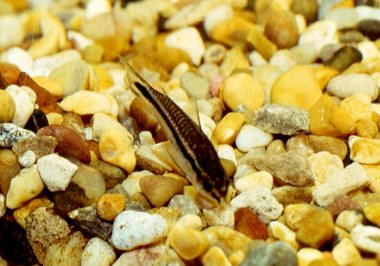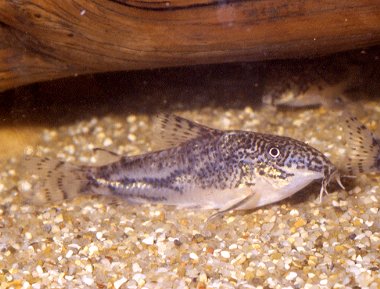2.
There are many ways of setting up tanks that are suitable
for Corydoras, I think the main criteria would
be what are the ingredients needed to create the ideal
Corydoras environment? For me these would be,
a) Tanks that are large enough to house the fish you
intend to keep. (See answer 3). b) A smooth substrate
to prevent damage to mouthparts. c) Quality water
= Clean and aged for at least three days, with near
neutral values pH6.8 - 7.4, GH10 - 15, and a temperature
of between 70º - 76º Fahrenheit would be
a good starting place. Most water authorities supplies
although they may vary in values from one authority
to another, are quite adequate for most species.
There are two
types of set up that I use. The first is a community
tank set up that is primarily aimed at housing Corydoras,
in which other fish are added to give the tank a visual
balance. External power filters are used on my community
tanks because of the substrate I use, which is either
fine smooth gravel no larger than one and a half millimetres,
or well washed river sand which very quickly clogs
under gravel filters. The depth of the substrate is
quite shallow no more than fifteen or sixteen millimetres
deep, this allows the Corydoras to search
out food particles right down to the base of the tank.
This prevents the problem of food particles filtering
deeper than the catfish can reach and souring the
substrate.
For tank decoration
I use pieces of bogwood with either Java fern or Java
moss attached, and although the substrate is fairly
shallow I have found most plants such as Cabomba and
Elodia will and do grow well. Java fern is particularly
good because it can be attached to a variety of tank
decorations, be it wood, slate or rocks. If it is
held in place with the aid of an elastic band it will
attach itself in a very short space of time. It is
a very tough plant and will grow well under a wide
range of conditions.
The second type
of set ups that I use are purely for breeding and
raising fry. These tanks vary in size from 20cm x
20cm x 20cm which house small species, to 90cm x 45cm
x 20cm which are stock /fry rearing tanks. The size
of the tank for breeding is relatively unimportant
so long as it is large enough to house the fish that
you are intending to breed. In the small 20 x 20 x
20cm tanks I keep and breed small species like C.
xinguensis and C. griseus.
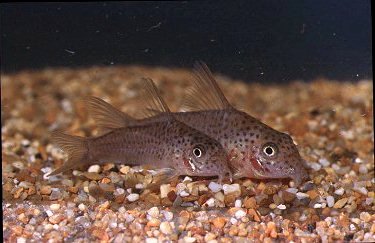
C. xinguensis
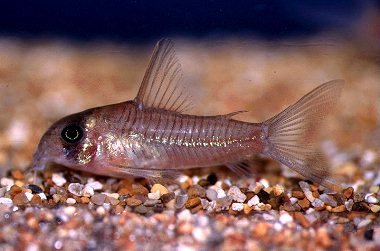
C. griseus
All of my breeding and rearing tanks have a ten to
fifteen millimetre layer of either river sand or fine
smooth gravel in them. I have in the past and do still
occasionally use tanks without any substrate at all
in, these are mainly for quarantining or raising delicate
fry in where uneaten food and waste matter can be
seen and removed easily with the minimum of disturbance
to fish or fry concerned.
The types of filtration
used in the small 20 x 20 x 20cm tanks are sponge
filters. Box filters are used in the medium sized
tanks (45 x 25 (30) x 25cm), and in the larger 90
x 45 x 20cm stock/fry rearing tanks the filters are
home made under gravel box types with power heads
fitted. If I need extra filtration I use an external
canister type filters.
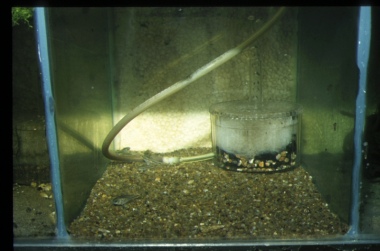
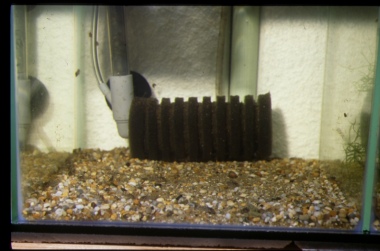
3.
The number of Corydoras that can be housed
in any one tank is much a matter of choice, but if
you bear in mind that they are shoaling fish and are
generally happiest in-groups of six or more. My recommendation
would be six to eight inches of fish to every square
foot of base area. When calculating do not count the
caudal fin (tail) as part of the fishes length its
the body length that counts.
4.
In the main most of the Corydoras species that
are available are quite hardy and not too difficult
to keep and maintain in good health. Therefore the
choice of species to start with will probably have
more to do with finance than anything else. There
are species such as Corydoras aeneus and Corydoras
paleatus that have been in the hobby for many
decades, these are being commercially bred in there
thousands in far eastern fish farms and can be bought
for one or two pounds each depending on their size.
At the other end of the scale there are species like
Corydoras solox and Corydoras gracilis
that have asking prices of up to fifty pounds sterling
each.
For those people that have
never kept Corydoras I would recommend some
of the less expensive species, which should be available
for under a fiver each, some of them are quite striking
in their markings and are ideal species to start with.
Here are a few to look out for Corydoras trilineatus
and Corydoras schwartzi have sharp black
and white markings. Corydoras metae, Corydoras
melini, and Corydoras rabauti have tan
coloured bodies with dark bands across the back. Then
there's one of my all time favourites Corydoras
arcuatus (the skunk catfish), with its white body
and arching black band that runs from snout over the
back to the tail. For those of you looking to try
your hand at breeding need look no further than
Corydoras aeneus, its albino form or Corydoras
paleatus, these are probably the easiest of all
Corydoras to breed.
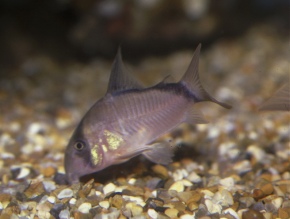
Corydoras
metae
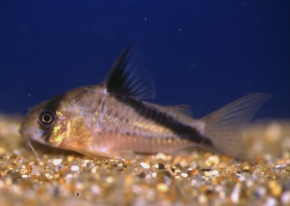
Corydoras
melini
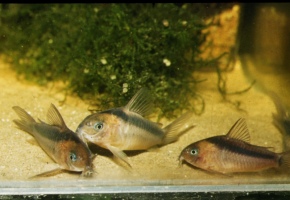
Corydoras
rabauti
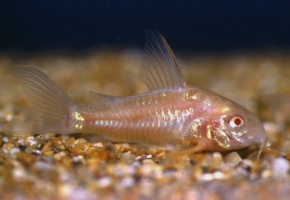
Corydoras
paleatus (albino)
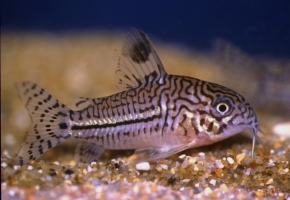
Corydoras
trilineatus
5. There are several
sources to acquire Corydoras from some of them
are better than others. The first place to look is
in your local aquatic shop the choice of species there
may be limited, but most if not all aquatic shops
will have at least a couple of species on offer.
To find a larger
choice of species you may have to travel a little
further a field to one of the shops that specialises
in catfish. There are a few of these establishments
around the country where the choice of species will
seam almost endless. I have been known to make a round
trip of over four hundred miles in a day because certain
shops have got the species that I have been searching
for.
A third source
of supply is from someone that is breeding Corydoras.
The biggest advantage with buying from a breeder is
that you will know the conditions the fish have been
bred and raised under, how old they are and the best
types of food to feed them on. This last point is
something that is almost impossible to determine with
wild imported fish.
6.
When buying Corydoras there are a number of
important things to look out for, to insure that you
are selecting good quality stock. It is probably easier
to list the fish to avoid and add the good points
later. a) Sunken eyes, b) Red blotches in the abdomen,
c) hollow belly, d) inflamed gills, e) Missing or
badly worn barbels, f) Deformities. (Pics of bad points).
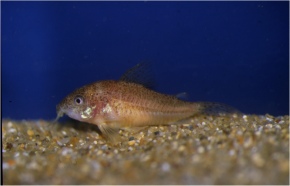
Fish that have sunken eyes are old and almost at the
end of there lives. Those fish that are showing red
blotches in the abdomen have an infection in the gut,
which in most cases is fatal. These fish should be
avoided and not given a second look because the chances
are they will not survive for more than a few days.
Fishes that have sunken or hollow bellies may survive
given the right kind of conditions and feeding. I
would still leave these fish alone. Reddened / inflamed
gills are also a sign of infection which may or may
not be easily cured, if the fish was rare and the
price was right then I might take a chance, but normally
I would leave these fish alone.
The barbels of
Corydoras are very important sensory organs used
for detecting and searching out particles of food
from the substrate, and were the females are concerned
playing a major part in the breeding activity. Badly
worn barbels may result in infection and mouth fungus
so again these are fish that I would avoid. Any fish
that are showing deformities are definitely given
a miss; although they may be perfectly healthy they
may pass on their deformities to their offspring.
Freshly imported
fish quite often arrive with damaged Finage, splits
or with pieces missing out of them in most cases the
damage will grow out and is not normally a danger
to the fish's health.
Now that we've
seen the undesirable fishes 'what does a good one
look like' I here you ask, well a quality Corydoras
should have. A full rounded body, sparkling eyes,
good barbels, a full set of seven fins, the flanks
and gill covers should be covered by a metallic sheen
and finally it should be reasonably active, although
there are some species are far more active than others.
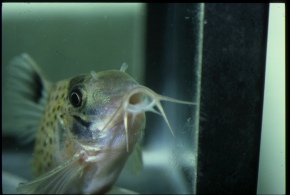
7. The choice
of food is very important with any fish you keep and
not just Corydoras. I use a variety of foods
both commercially manufactured as well as cultured
and collected live foods. My feeding program is based
around a staple diet of either a pre-soaked (so it
sinks to the bottom straight away) quality flake or
sinking tablet food. The tablets are crushed before
given to the smaller species and crushed powder fine
for fry.
Live foods come
in a variety of forms the following are the ones that
I mainly use, none aquatic = Microworm, whiteworm
and earthworm finely chopped. Aquatic = Brine shrimp,
daphnia, tubifex and bloodworm. All live foods are
given in small amounts, ideally as much as the fish
will eat in five or ten minutes.
There are also
frozen foods that are very good especially during
the winter months when live foods can be harder to
come by, the range of frozen foods are quite extensive
from Cyclops to muscles and these day's most aquatic
shops stock them. It doesn't hurt to try these out
now and again; I've not found any that my fish won't
eat, although some may need grating down to a size
that can be consumed easily. During the summer when
daphnia is plentiful I will collect as much as I can,
drain of the water when I get home and freeze it in
plastic bags. I roll it out flat so that it is in
sheets of about the same thickness as a medium slice
of bread, (10mm thick) this makes it is easier to
break pieces off to feed to the fish, and each bag
contains enough daphnia to feed all my fish.
Feeding takes
place twice daily when ever possible. When time permits
the morning feeds will consist of flake (pre-soaked)
or tablet foods only. In the evening the tanks that
are scheduled for water changes have this done first
then the fish are fed, however all the fry tanks have
daily water changes before feeding commences.
8.
Sexing Corydoras is not always the easiest
thing to accomplish especially with freshly imported
fishes, so I will explain how I go about the task.
To start with there are three areas where I look or
differences.
The first is colour,
which is probably the easiest area where differences
will show. With most Corydoras species there
are no discernible colour differences, but in those
that do show colour dimorphism it's the males that
poses the brighter more intense colour patterns. There
is however a danger here because with some of these
species the colour differences are so great you could
quite easily think that you are looking at two separate
species.
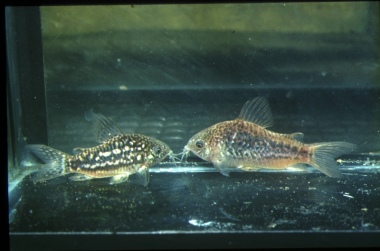
The first thing
to do is ask the retailer if they have been brought
in as the same species, if they were then there's
a fair chance that they are the same species. I would
then take two of the brighter coloured specimens to
every one of the lesser-coloured ones. If there is
any doubt then I would take equal numbers of each.
Most Corydoras species belonging to the 'elegans'
group do show colour dimorphism.
The second area
I look at is the Finage. Mature male Corydoras
almost always have longer and more robust fin spines
than females in particular the pectoral fins and to
a lesser extent the dorsal fin, with some species
the differences are so small that it is virtually
impossible to see. With other species the differences
are quite dramatic to the point were the males fins
can be twice the length of the females.
When there are
no discernible differences visible in the Dorsal or
Pectoral fins the area I look at next is the Ventral
fins. If there are any fin differences to be seen
at all it will be here with males having longer, narrower
and more pointed ventral fins than the females, which
will be far more rounded and fan shaped.
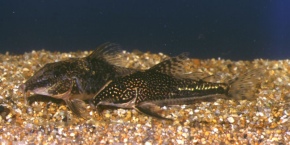
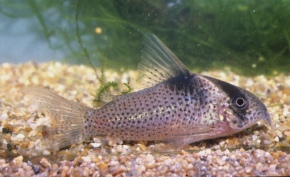
The third and final area
that I look at is the body, when viewed from above
the widest part of the females body is at a point
just forward of the insertion of the ventral fins.
In males the widest part of the body is at or just
behind the insertion of the pectoral fins. When viewed
from the side females show a deeper more rounded body
shape, were males should look slender and far more
streamlined. There are other characteristics that
can also help to differentiate the sexes, for instance
Corydoras barbatus males have bristles on the
cheeks and females don't. So with species that are
difficult I will look for anything that can separate
them. On the occasions when I find it impossible to
separate the sexes I will buy at least six specimens
or more if the price is right. Once you have had the
fish for a while and conditioned them the sexes will
be relatively easy to separate.
9.
Breeding Corydoras in it's self is not difficult
the fish do that with relative ease all on their own,
the difficult part it triggering them to do so in
the first place. There are many conditions that need
to be met before they will breed. Some times all that
is required is a change of water of the same temperature
to set them of (Corydoras pygmaeus). The next
stage would be a change of water that is slightly
cooler, five or six degrees Fahrenheit is enough to
promote spawning interest, Corydoras aeneus,
Corydoras paleatus and Corydoras panda
are typical of the species that will respond to the
cold-water treatment. Once the basic water change
methods have been tried then things start to get a
little more difficult and other methods need to be
used. The one thing that I do when trying to encourage
a species to spawn is only try one thing at a time,
this is because the first thing you changed may have
been the right trigger. The second change may counteract
the first and put the fish off spawning altogether.
This may sound a bit like basic common sense to many
of you, but it is surprising how many people tell
me all the things that they have done to try and trigger
there Corydoras to spawn. When asked they tell me
several condition changes were made at the same time.
I would also
recommend keeping notes as in my opinion they are
invaluable especially when trying to breed some of
the more difficult species. These notes can be referred
to at any time to see the changes that have been made,
or used to help formulate a series of changes that
you think may trigger a spawning. The following is
a list of the things that I would do in order to encourage
a species to spawn given that the fish are in spawning
condition. a) A weekly water change with no temperature
change. b) Twice weekly water changes with no temperature
change. c) Daily water changes with no temperature
change. Then a, b, and c, again this time reducing
the temperature by six to eight degrees Fahrenheit,
after the cooler water changes the same sequence would
be applied using warmer water again six too eight
degrees Fahrenheit. There are some species of Corydoras
that prefer warmer temperatures Corydoras gossei
is one of these. I will change the same amount
of water approximately fifty percent for every water
change made to maintain consistency. My next move
would be to extend the time between water changes
from one week to two weeks and then three or even
longer, first with equal temperature water then with
cooler water. If all these measures failed then I
may try reducing or raising pH values, then the general
hardness lowered or raised. These are the list of
things that could trigger a spawning is endless as
is the time needed to implement them, so I would say
the main ingredient to successful Corydoras breeding
is patience and lots of it.
10.
The number of described Corydoras species is
now one hundred and fifty four, with many more species
as yet undescribed arriving in aquatic shops all over
the country almost weekly, making the choice for customers
almost endless.
Photo Credits:
Top 2 images: Danny Blundell
Rest of images by the author ©
Ian Fuller @
